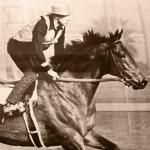
A Horse Racing Fan’s Guide to Holiday Movies and TV

Up to 20 lightly raced 3-year-old Thoroughbreds get loaded into the starting gate with somewhere in the neighborhood of 150,000 fans (many well-lubricated) whipped into a frenzy. Approximately two minutes after the horses begin the cavalry charge down the stretch for the first time, a new Kentucky Derby winner is feted in the winner’s circle.

The first jewel of Thoroughbred racing’s Triple Crown is a compelling combination of pageantry, speed, drama, stamina, and chaos. With that many 3-year-olds jockeying for positioning, facing challenges from other horses, and needing at least some element of luck to emerge victorious, Kentucky Derby favorites would seem to be in a precarious position. But in 150 editions of the Kentucky Derby, favorites have won at a 37.3% rate (56 of 150).
Exploring the Derby longshots with be the subject of a later blog. The focus here is Derby favorites and some fun facts about the 3-year-olds who started as the top betting choice in the run for the roses. (Note: For this exercise only the best finish was considered when it comes to favored coupled entries, where two or more horses were coupled as one entry and sent off as the favorite.)
1) The longest stretch of consecutive winning favorites since the first edition of the race in 1875 came recently. From 2013 to 2018 favorites won six straight editions of the race: 2013 Orb (5.40-1), 2014 California Chrome (5-2), 2015 American Pharoah (2.90-1), 2016 Nyquist (2.30-1), 2017 Always Dreaming (4.70-1), and 2018 Justify (2.90-1).
2) In the six editions since 2018, none of the favorites has won, although two finished second (Tiz the Law, 2020; Epicenter, 2022) and two finished third (Essential Quality, 2021; Angel of Empire, 2023).
3) Favorites went a remarkable 20 years without a win in the Kentucky Derby from 1980 through 1999 before Fusaichi Pegasus ended the drought with a win as the 2.30-1 top betting choice in 2000. After Spectacular Bid’s win at 3-5 odds in 1979, not a single favorite won in the 1980s or 1990s and in only six editions during that span did the favorite finish in the top three.
4) Favorites dominated the early runnings of the Kentucky Derby, winning seven of the first 12 editions with four runner-up finishes and one third, from favored Aristides win in 1875 through favored Ben Ali’s victory in 1886.
5) In fact, favorites won 21 of the first 41 editions of the Kentucky Derby (51.2%) and finished second another 13 times in that span while finishing in the top three 90.2% of the time.
6) Favorites also won 12 of 20 editions (60%) of the Kentucky Derby from Black Gold’s win as the 1.75-1 favorite in 1924 through Count Fleet’s win as the 2-5 favorite in 1943.

7) Kentucky Derby favorites also fared well from 1961 to 1979, starting with Carry Back’s win as the 5-2 favorite and ending with “the Bid’s” win as the overwhelming betting choice. During those 19 editions, favorites amassed nine wins, five seconds and three third-place finishes with only a pair of unplaced favorites. That’s 89.5% top-three finishes during a stretch that included Triple Crown sweeps by Secretariat in 1973, Seattle Slew in 1977, and Affirmed in 1978. (Note: Affirmed’s rival Alydar was the 6-5 betting choice in the 1978 Kentucky Derby).
8) Overwhelming favorites have not fared quite as well as you might expect since the start of pari-mutuel wagering in 1908 with only six of the 13 favorites at odds of 4-5 or lower prevailing: 1943 Count Fleet (2-5), 1948 Citation (2-5 as entry with stablemate Coaltown), 1977 Seattle Slew (1-2), 1939 Johnstown (3-5), 1979 Spectacular Bid (3-5), and 1912 Worth (4-5). However, six others ran second, including 2-5 favorites Bimelech in 1940 and Honest Pleasure in 1976.
9) The lowest price for a favorite in the pari-mutuel era is the 2-5 odds carried by Bimelech, Count Fleet, Citation/Coaltown, and Honest Pleasure (see above), while the highest price for a favorite in Kentucky Derby history was Lookin At Lucky, who finished sixth at 6.30-1 odds in 2010.
10) Counting only the best finish when it comes to favored coupled entries (where two or more horses were coupled as one entry and sent off as the favorite), Kentucky Derby favorites have only finished outside the top three 48 times in 150 editions (32%). So, there is a very good chance the betting favorite will at least finish in the top three.